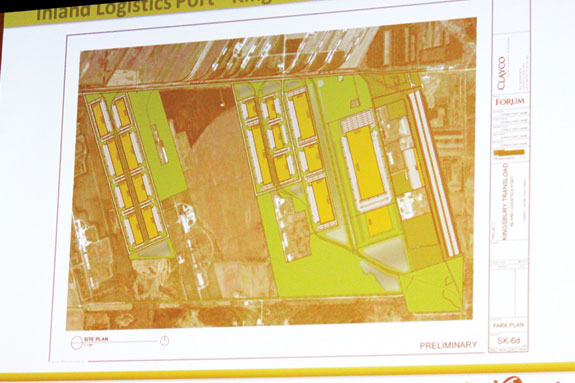A new mode of transportation is poised to be a “game changer,” providing the ability to move fresh, chilled and frozen bulk and value-added food products from the Midwest to the Southeast and beyond. For Indiana Dairy Producers, the Green Express is emerging in their home state at the site of the former Kingsbury munitions plant and CSX rail line, an hour south of Chicago.
The site is unique for its ability to have a mile-long stretch of straight track for exit, and to lift and load shipping containers.
This “magic spot” is not only within 12 miles of access to four U.S. highways and three interstates, it is the epicenter of the Upper Midwest “consumption zone” of 41 million people – the second largest in the U.S.
In March 2014, this new mile-long, high-speed, non-stop, refrigerated “food train” will begin transporting chilled and frozen food products – namely produce and juices – from Tampa, Florida, to northwest Indiana and back again.
Add to this the massive ongoing project to double the capacity of the Panama Canal, and the result is an efficient combination of transportation advances to get cargo from the eastern U.S. and Gulf ports to global destinations.
Organizers of the “food train” envision selling Midwestern commodities to resort buyers in the Caribbean, Central America and South America, as well as tapping growing markets for dairy protein in the Pacific Rim, including China.
But it all begins with the north-south route between Kingsbury and Tampa – driven by the distribution logistics of large food buyers Walmart, Aldi and Costco.
“We’re connecting the pieces and combining the parts to help get their stuff up here and our stuff down there,” said Chris McGrath, an ownership partner and developer of the logistics park that will operate the Green Express, Chicago-based Providence Logistics.
“We’re optimizing the supply chain to get product distributed faster and fresher, with less waste and less spoilage, while realizing savings in fuel costs as well as other downstream benefits.”
McGrath spoke during the Indiana Dairy Producers (IDP) annual Partners in Success luncheon in the Farm Bureau building at the Indiana State Fairgrounds October 25 in Indianapolis.
He unveiled the current status and future plans for the Green Express, funded through the private investment of the Providence Logistics partners, along with LaPorte County’s investment in site improvements to the logistics park and CSX rail line. The luncheon was sponsored by the Indiana Soybean Alliance and Corn Marketing Council.
As the Green Express begins rolling, bringing produce and juices north, key opportunities will emerge for dairy, bacon and beef on the backhaul south.
For example, the 250-mile radius near Mexico City is an 80-million-person “consumption zone” dwarfing any consumption zone in the U.S. Mexico represents a large market for U.S. dairy and meat protein.
According to the International Trade Commission (ITC), U.S. agricultural exports to Mexico were $18.9 billion in 2012 – the third-largest U.S. export market. Of that total, dairy products accounted for $1.2 billion and red meat $1.9 billion.
The Caribbean is also a key global importer because its dairy sector faces land constraints to meeting rising demand for cheese, milk and other products, according to the U.S. Dairy Export Council (USDEC).
In addition to a population of 36 million people, 16 million vacationers and millions more visitors on cruise ships make this a market that is growing and well- tuned to the U.S. mainland for food trends.
“The Green Express piqued my interest and the interest of our board right out of the gate as a real opportunity for dairy,” IDP executive director Doug Leman said. “To have value-added fresh and frozen dairy products leaving the country sounds like a slam dunk to me.”
McGrath explained how these transportation advances open a new world of marketing potential for dairy, and it doesn’t stop with the Kingsbury-Tampa route.
A future phase is planned within the 52-million-person Northeast consumption zone for non-stop routes between Philadelphia and Tampa as well as between Kingsbury and Philadelphia, leading to potential direct transport of products to and from Europe.
Curiosity was evident in the 80 luncheon attendees – including IDP board members, advisers and representatives of the many allied industries that support IDP.
McGrath answered questions about how fresh dairy products can hitch a ride on the backhaul from northwest Indiana to Tampa, Florida, with port-to-port “international trade zone” status on the food train.
This trip takes 52 hours by truck and 56 hours by train; however, the international trade zone status at both ends of the track allows the product on the train to be deemed exported or imported so it can be immediately offloaded and distributed upon arrival without waiting the many days of administrative time required for inspections.
This cuts days of transit time off the freshness ticker for perishables like produce and juices, meats, milk and value-added dairy products.
“What we envision is ‘steady-Eddie’ freight by rail for the long haul and the use of trucks to manage spikes in capacity and for local and regional distribution within those consumption zones,” McGrath explained.
 “We’re thinking outside the box,” Leman noted. He and Andy Tauer of the Indiana Soybean Alliance have been promoting the Green Express to dairy cooperatives and proprietary plants over the past year, while the Indiana Department of Agriculture is promoting the idea of a “food campus” to processors of various commodities from fruits and vegetables to beef, bacon and milk.
“We’re thinking outside the box,” Leman noted. He and Andy Tauer of the Indiana Soybean Alliance have been promoting the Green Express to dairy cooperatives and proprietary plants over the past year, while the Indiana Department of Agriculture is promoting the idea of a “food campus” to processors of various commodities from fruits and vegetables to beef, bacon and milk.
McGrath also stressed this is not the rail transit of yesteryear.
Not only do the rail units have specialized food quality optimizers, including GPS controls – the rail service is a dedicated, high-speed, non-stop transit, moving a hybrid of containers from grain and lumber to boxcars of chilled fruits and vegetables to ISO tanks moving fruit juice from Tampa to Kingsbury, positioning milk as a potential backhaul.
In fact, ISO tanks are not only thermally insulated and refrigerated, they are marine-ready, meaning they can go from plant to rail to ship, seamlessly.
“We have the ability to move large volumes of refrigerated (and frozen) products north and south,” McGrath said, “And we have the available land for companies to vertically integrate to generate retail-ready products at one location.”
For example: “Florida and Indiana are No. 1 and No. 2 in watermelon production, with opposite growing seasons,” McGrath said. “Processors who cube melons for lunch cups commonly sold at convenience stores must have melons at 40 degrees for that process.
Instead of waiting a week in a warehouse to cool the interior of the melons to that point, the process can start in the chilled boxcar on the Green Express. So now, we’ve not only lowered their transportation cost, we’ve also lowered warehouse capacity needed for this operation and their energy costs.”
How viable is the dairy market beyond Florida? And what scenarios are possible for dairy in the future? McGrath said there are many unexplored ways to utilize this transit option for the domestic dairy market, as well as exports.
“The thing dairy producers need to figure out is their own logistics. Is it better to move dairy by ISO tank on a backhaul or in packaged form?” McGrath suggested.
“What we’re offering is the ability to move food in any form. We can connect the dots, but producers have to decide who they are connecting their product to, and what are the dots we can help them connect?”
“It will take a little time to line things up and make things work, but this is all very doable,” Leman observed, adding that the infrastructure is here to make it happen, and that producers and processors would lease the refrigerated tanks and boxcars to move their products on the Green Express for direct-to-port offload to shipping vessels.
“We can do it,” said Leman. “IDP’s role is to get this conversation going. That is key because most people don’t even know this opportunity is coming down the track.
A rising tide lifts all boats. If we can raise the value of our product by getting it on the Green Express and getting it out of here, that’s good for everyone and helps position us to expand our dairy industry.” PD
Bunting is a freelance writer in eastern Pennsylvania.
PHOTOS
TOP RIGHT: Calling it a “game changer,” logistics company owner Chris McGrath unveiled the current status and explained the future potential of the Green Express, a new refrigerated rail train, to Indiana dairy producers at a luncheon Oct. 25 in Indianapolis.
MIDDLE RIGHT: The Indiana Department of Agriculture envisions a “food campus” at the site of the Green Express. Not only does the site have a mile-long rail line for lifting and loading containers but also the available land to attract companies for further processing and distribution. Photos courtesy of Sherry Bunting.





